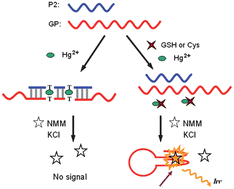Ruqin Yu and colleagues from the University of Hunan, China, have developed a label-free fluorescent detection system for glutathione (GSH) and cysteine (Cys).

Hg2+ mediated fluorescent sensing strategy for detection of GSH and Cys
Three key interactions are necessary for the development of this assay: two single stranded DNA with thymine-thymine (T•T) mismatches stabilised in the presence of Hg2+, GSH and Cys interaction with Hg2+ with much higher binding affinity than T•T mismatches, and interaction of N-methyl porphyrin IX (MMP) with G-quadruplex structures, which leads to increased fluorescence.
The researchers judiciously designed two sequences of DNA such that inter-molecular T•T mismatches were stabilised in the presence of Hg2+, inhibiting one of the stands from forming a G-quadruplex. When the Hg2+ interacts with GSH or Cys, an intramolecular G-quadruplex is formed. The G-quadruplex interacts with the NMM producing a marked increase in fluorescence. Contrarily, in the absence of GSH and Cys, the Hg2+ is available to stabilise the mismatched duplex, the G-quadruplex is not formed, no NMM binding occurs and no fluorescent increase is observed.
This system was successfully used to detect GSH or Cys from protein extracted from human serum samples. To read more about this work, please access the full article below. It will be free to read until February 28th.
A Hg2+-mediated label-free fluorescent sensing strategy based on G-quadruplex formation for selective detection of glutathione and cysteine
Jingjin Zhao , Chunfei Chen , Liangliang Zhang , Jianhui Jiang , Guoli Shen and Ruqin Yu
Analyst, 2013, Advance Article
DOI: 10.1039/C3AN36657J










